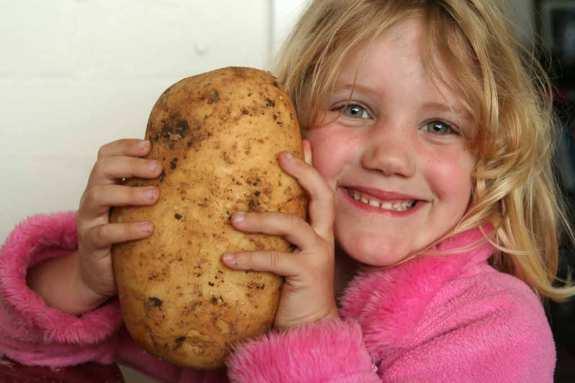
8 minute read
The Potato
from englishlnhot2182020
by nikolatysh


Advertisement
F i s h & C h i p s ! ! ! The Potato
Learn lots of fascinating things about the potato.
Potatoes have been farmed in Peru for at least 4,000 years. However, Europeans didn’t find out about them until the 16th century. In 1524 the Spanish landed in South America and found all kinds of new things to eat: tomatoes, peanuts, cacao beans, hot peppers, and potatoes. A journal entry by an anonymous member of a Spanish expedition in 1536 described the potatoes he found in the Andean village of Sorocota as dark and small, almost as small as peanuts.
At first, the potatoes were used to feed ships’ crews. It stopped them getting scurvy. Many people were frightened of the potato because it is a member of the deadly nightshade family, all of which are very poisonous. But very soon, the potato became a staple food. It was a more reliable crop than wheat.
European immigrants took potatoes to North America several times throughout the 1600s. At first, they were mostly used as animal fodder. Ironically, the potato, which had saved so many lives, was responsible for a terrible famine in Ireland. The potato had been introduced into Ireland in the mid-1700s. By the 1800s, Irish peasants were eating a daily average of 10 potatoes per person. The potatoes supplied about 80% of the calories in their diet, plus the potatoes were used to feed their animals – animals which provided milk, meat and eggs to supplement their diet. This dependence on one food crop was dangerous, but no other crop seemed to be so reliable. But in the 1840s, disaster struck. There were three successive years of “late blight” (a microscopic fungus), and this fungus destroyed the potato crops in the ground. Without potatoes, both the peasants and animals went hungry. And when the animals died, there was no more milk, meat and eggs. More than one million of Ireland’s 8 million inhabitants died of starvation; and almost 2 million emigrated (mostly to America). The population of Ireland was reduced by almost 25% (and has never regained its former numbers to this day).
In America, the fried potatoes you get in McDonald’s, etc, are called French fries. In Britain, they’re known as chips.
The first commercial use of French fries is supposedly in 1864 when Joseph Malines of London put “fish and chips” on the menu. His success inspired others across Europe.
One of the first recorded accounts of the use of the word “French” fries is from Thomas Jefferson. He tried them in Paris and brought the recipe home. At a White House dinner in 1802, the menu included “potatoes served in the French manner”. But that’s not how they got their name.
French fries actually got their name in 1918. During World War One there were many American soldiers in France. They ate lots of the fried potatoes and they called them “French fries”. They liked them so much they wanted to have them at home, too. These days, Americans still love French fries: in just one year more than 2 billion kilos of them were sold in the US.
A Native-American chef called George Crum gets the credit for inventing potato chips (or “crisps” as they are known in Britain). He did it by accident in 1853, thanks to a cranky customer: railroad magnate Commodore Cornelius Vanderbilt. One evening, Vanderbilt was in the Moon Lake House Hotel in Saratoga Springs, New York when he ordered some fried potatoes. He wanted them really thin, the way the French made them. He kept sending them back to Mr Crum, saying that they were too thick. Finally, Mr Crum decided he’d had enough, and cut the potatoes paper-thin, fried them to a crisp, then covered them with salt. Vanderbilt thought they were great, and after that, “Saratoga Crisps” became a popular item on the hotel’s menu.
The word “ketchup” comes from the Siamese word “kechiap”, which is a
R o a s t p o t a t o e s ! ! !
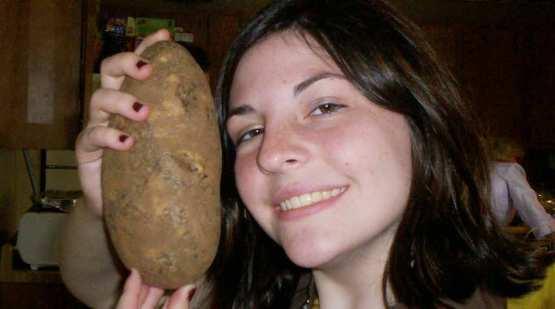
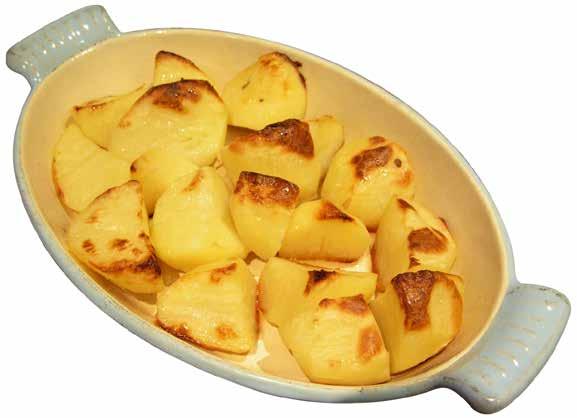
tangy sauce made from pickled fish. It was first prepared in the 1600s. In the 1700s, British sailors took it from Singapore to England. They spelled it “ketchup”, and tried to copy it using mushrooms, walnuts, and cucumbers. The earliest recipe for “tomato catsup” appeared in 1792, and in 1841 Charles Dickens wrote about “lamb chops breaded with ketchup” in the book Barnaby Rudge. Finally, in 1876, the GermanAmerican chef and businessman Henry Heinz made the first mass-produced and bottled tomato ketchup.
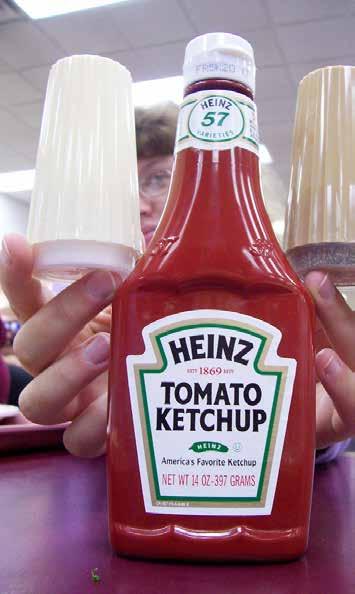
The state of Idaho is the centre of potato cultivation in the US.
An informal expression for someone who spends all day on the sofa, doing nothing, is a “couch potato” (a “couch” is another word for a “sofa”).
A “hot potato” is something that is difficult or dangerous to deal with. For example: “The use of the veil in schools is a political hot potato in Europe.”
To “drop something like a hot potato” is to stop being involved with something because you are worried about the negative consequences. For example: “The company had wanted to sell the controversial video game. However, they dropped their plans like a hot potato when they realized the bad feeling the game was causing.”
Vice president Dan Quayle once made a real fool of himself. A school student had written the word “potato” on the blackboard.
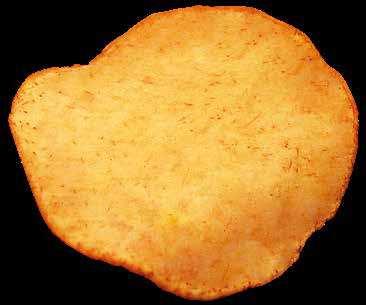
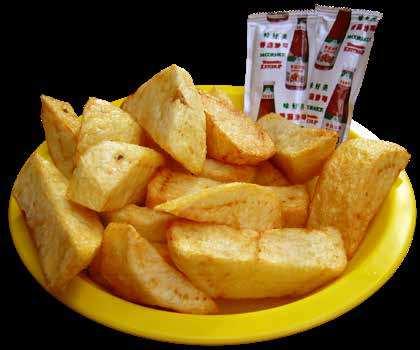
Mr Quayle then “corrected” GLOSSARY the student and added to find out phr vb to discover an “e” to the end of a crew n the word making the people who work on a ship scurvy n it “potatoe”. Of course, the plural a disease that is caused by a lack of vitamin C deadly nightshade n form does have an a type of plant that is poisonous poisonous adj “e” (and an “s”) at that contains a liquid that can the end, “potatoes”, kill you a staple food n but Mr Quayle was wrong. the food that is basic and important for people reliable adj Some alternative that you can trust; that never fails animal fodder n and informal food for animals words for potato include a famine n a period of time when there is “spud” and “tater”. For example: “Would you like some spuds with that?” P o t a t o w e d g e s ! ! ! no food to supply vb to give or provide with something needed to feed vb to give food to disaster struck exp something terrible happened three successive years n
POTATO RECIPES for three years, one after the other to go hungry exp to be hungry because there is
Boiled potatoes – cooked in hot water. Often served with butter no food a menu n a list of the food and drinks
Roast potatoes – potatoes cooked with oil in the oven. Often served available in a restaurant with roast meat to get the credit for something exp
A baked potato – cooked in the oven with to be the one considered responsible for something positive its skin (or “jacket” as it is also know). The cranky adj potato is often filled with lots of delicious things, including butter, baked beans, tuna, sausages, cheese, etc. Also known angry and in a bad mood to have enough of something exp to want no more of something paper-thin adj as “jacket potatoes” very, very thin – like paper to fry something to a crisp exp
Chips (French fries in the US) – thin, fried to cook something in oil until it is hard pieces of potato often served with hamburgers. tangy adj with a strong flavour or smell
Crisps (potato chips in the US) – thin pieces of potato sold in a plastic bag. pickled fish n fish that has been preserved in vinegar walnuts n
Mashed potato – this is a kind of potato purée that is often served with sausages. a type of nut with a wrinkled surface (one with many lines) to make a fool of yourself exp to do something that makes you
A potato cake (also known as the potato appear to be stupid scallop, or the potato fritter – this is really popular in Australia and is a thick slice of baked beans n white beans cooked in a tomato sauce potato that is fried in batter. batter n a mixture of flour, eggs and milk
Sauté potatoes – these are thin slices of potato that are cooked in hot oil. They are often served with cream that is used to cover fish before frying the fish the outer part n
Potato skin – this is the outer part of the potato that is filled with the part that is on the exterior bacon and cheese and baked in the oven. Delicious! to bake vb
Potato salad – a mixture of potato and mayonnaise. This is often served as an accompaniment to another dish to cook in the oven an oven n the electrical appliance in the kitchen for cooking an accompaniment n food that goes with a main dish










